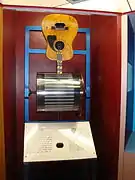Regional Science Centre, Bhopal
The Regional Science Centre, Bhopal (RSCB) is located in the Shyamla Hills area of Bhopal, India.[2] It is aimed at popularizing science and technology among the people, particularly the students. It is one of the constituent units of the National Council of Science Museums or NCSM.[3]
 A Rube Goldberg machine-like demonstration of the mechanical energy at RSCB | |
 Location of the Regional Science Centre in Bhopal, India | |
| Established | 12 January 1995 |
|---|---|
| Location | Banganga Road, Shyamla Hills, Bhopal - 462 002 |
| Coordinates | 23.259933°N 77.412615°E |
| Type | Science Museum |
| Visitors | 1,79,000 (April 2013-March 2014)[1] |
| Director | Krishnendu Choudhury (Project Coordinator) |
| Curator | Saket Singh Kaurav |
| Owner | National Council of Science Museums, Ministry of Culture, Government of India |
| Website | rscbhopal |
RSCB was inaugurated on 12 January 1995 by the then president of India Shankar Dayal Sharma.
Exhibits and facilities
The Centre has over 266 science exhibits spanning across a wide range of scientific disciplines. Most of the exhibits are interactive. The 5-acre RSCB campus includes a 3-acre Science Park, which contains over 60 exhibits such as pulley demonstrations, a windmill and solar-powered devices. The campus also houses a small Dinosaur Park and a zoo.
The RSCB is open on all days, including weekends, except on Holi and Diwali. The visitor timings are from 10.30 am to 6pm. As of 1 April 2014, the entry fees is ₹ 10 for visitors who are part of a student group, and ₹ 20 for everybody else. There are extra charges for special shows such as the 3D Film Show (₹ 20 per person) and the Taramandal Show (introduction to astronomy, ₹ 10 per person).
The Centre has a 200-seater auditorium and a 25-seater conference hall (both air conditioned). These are also available to the external groups for organizing relevant events, at a small charge. There is also a 50-seater AC hall, where the 3D Science Show is organised. RSCB has a small portable planetarium with an inflatable dome, with a capacity of 25 people.
RSCB also has a Mobile Science Exhibition bus with 24 exhibits. This bus goes to the small towns and remote villages of Madhya Pradesh and Chhattisgarh for creating scientific awareness through anti-superstition demonstrations, science-related films, sky observation and educational lectures.
 Visualizing Sound with a Guitar
Visualizing Sound with a Guitar "Head on a Platter" exhibit
"Head on a Platter" exhibit A model of the Indira Sagar Power Station
A model of the Indira Sagar Power Station The "Infinite well" exhibit
The "Infinite well" exhibit Virtual piano
Virtual piano The "Paint your painting in different ways" exhibit
The "Paint your painting in different ways" exhibit Moving skeleton of a bicyclist
Moving skeleton of a bicyclist Moving skeleton of a bicyclist
Moving skeleton of a bicyclist
Events
A sky observation programme is organized on weekends after the sunset, as well as for specific astronomical events which occur from time to time. Awareness programs and exhibitions are organized on special days such as the International Museum Day and the No Tobacco Day. Student exhibits and science fairs are also organized from time to time.[4][5]
Special lectures by scientists and professors are organized in celebration of commemorative days. Contests for students, film shows, awareness programmes, drama festivals, workshops and special exhibitions are also held to celebrate these days. Multi-day workshops are held for students during the summer vacations.
RSCB also organizes a one-week training programme for teachers and the would-be teachers on fabrication of simple, low-cost teaching aids. Science demonstration lectures are organized on request by school groups. RSCB offers memberships to individuals, families, schools and other institutions: the members can participate in the various activities and programmes organized by the Centre.
References
| Wikimedia Commons has media related to Regional Science Centre, Bhopal. |
- "Visitor Statistics". National Council of Science Museums. Archived from the original on 31 May 2012. Retrieved 23 April 2012.
- Michael Zils (2003). Museums of the world. Saur. p. 353. ISBN 978-3-598-20613-9.
- Sharyn Errington; Brenton Honeyman; Susan M. Stocklmeyer (2001). Using Museums to Popularise Science and Technology. Commonwealth Secretariat. p. 159. ISBN 978-0-85092-668-2.
- "Children's works displayed at Regional Science Centre". The Times of India. 23 December 2011. Retrieved 24 April 2012.
- "Annual Rural Science Exhibition attracts talent from MP". DNA. 15 November 2007. Retrieved 12 April 2012.